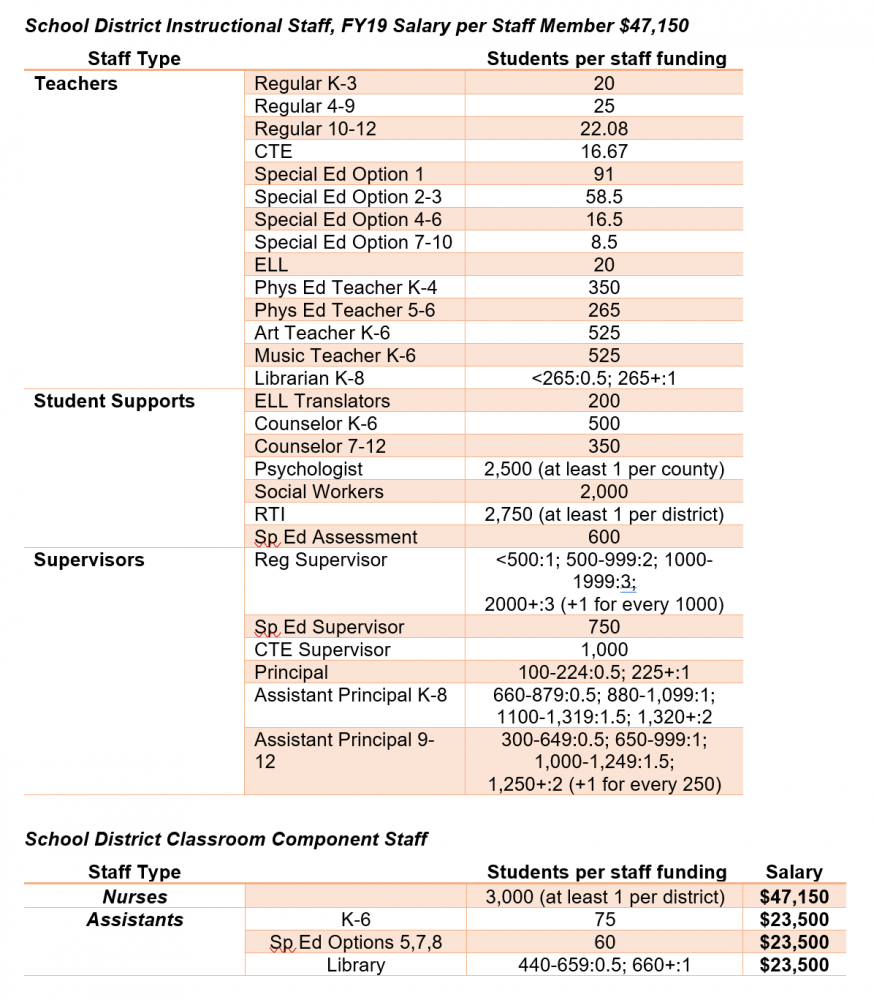Tennessee’s school funding formula, the Basic Education Program (BEP), delivers most of the funding provided by the state to Tennessee school districts each year. The formula divides funding into three categories: instructional staff (salaries and benefits) and classroom and non-classroom components. The state funds 70 percent of the instructional category, 75 percent of the classroom category and 50 percent of the non-classroom category; the remaining funding is from local district contributions.
Actual state and local funding percentages vary by district based on “fiscal capacity,” a calculation of the district’s ability to fund education with local resources. This ranges from 40 percent of BEP funding costs covered by the state in the Sevier school district to 90 percent of funding covered by the state in Union.
For the 2018-19 school year, as seen in the righthand chart below, $4.7 billion of the total $7.1 billion in the BEP formula was covered by state funds and the rest by local funds. Local and federal funds can increase district budgets; in 2018-19, about $2 billion and $1 billion, respectively, were added. A small amount of additional funding from the state is available to school districts as well.
The lefthand chart below demonstrates what 2018-19 funding looks like in per pupil amounts by various funding categories. Further details about each category can be found below and in the BEP Blue Book and the BEP Handbook for Computation.
Total teacher salaries (for about 55,600 teachers) represent approximately $2,700 per pupil. Other staff salaries add another $630 per pupil, with benefits adding about $1,400 per pupil. The county cost differential factor (CDF) adjusts funding for districts where cost of living is higher, but only adds $36 per pupil, while at-risk funding for students in poverty adds $311 per pupil to costs statewide. Other class components add just under $500 more per pupil, while non-class components add $2,090 per pupil. The chart below can be changed to view per pupil and total funding amounts for each district as provided by the BEP formula.
Instructional Staff
District instructional staff funding is based on the number of students in the district, the salary allowed for the staff category, and a set number of students per staff member. For example, if a district has 100 students in kindergarten through third grade, classroom teachers for these students would be funded at a salary of $47,150, at a rate of 20 students per staff member, or five teachers total. This means the district would be allotted $235,750 for those teachers (100/20*47150). Some instructional staff funding counts are based on the number of certain types of students. For example, one English language learner (ELL) teacher is funded for every 20 ELL students in the district.
Because the staffing components are calculated based on student-to-staff ratios, funds may not be provided to fully fund the salary of a given staff member in a district. For example, if a district has 400 students, with a funding rate of one counselor for every 500 students, and one social worker for every 2000 students, that would mean the district would be allotted funding for 0.8 of one counselor’s salary, or $37,720, and 0.2 of one social worker’s salary, or $9,430.
Funding for insurance and retirement benefits are also included in the instructional staff components and classroom components (see next section) and are based on the BEP funded salary amount.

Classroom
Nurses and assistants are funded as “classroom components” through the BEP formula rather than as instructional staff. Along with these staff members, there are a few additional categories funded in this group. County CDF is used to adjust salary components for districts where the cost of living is substantially higher than in other districts. However, this element was funded at 20% for qualifying districts in 2018-19, and is now being phased out. At-risk funding is added to the formula for every student in poverty, at a rate of $885.75 in 2018-19. In addition, substitute teachers are funded at a rate of $61.75 per student. Some other funding is included in this component for classroom-related items, such as textbooks and other instructional materials.
Non-Classroom
The last category in the formula is non-classroom components, which include system support, transportation, maintenance and operations, and capital outlay funds. Salaries and benefits for secretaries, custodians, a superintendent, and a technology coordinator are also included in this category.